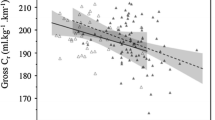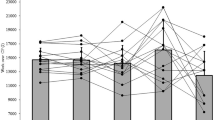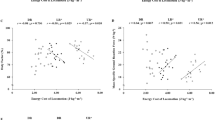Abstract
Purpose
Challenging environmental conditions including heat and humidity are associated with particular risks to the health of runners and triathletes during prolonged events. The heat production of a runner is the product of its energy cost of running (C r) by its velocity. Since C r varies greatly among humans, those individuals with high C r are more exposed to heat stress in warm and humid conditions. Although risk factor awareness is crucial to the prevention of heat stroke and potential fatalities associated therewith, how C r affects the highest sustainable velocity (V) at which maximal heat loss matches heat production has not been quantified to date.
Methods
Here, we computed in virtual runners weighting 45–75 kg, the influence of C r variability from 3.8 to 4.4 J·m−1·kg−1 on V. Heat loss by radiation, convection, and conduction was assessed from known equations including body dimensions, running velocity (3.4–6.2 m·s−1), air temperature (T a, 10–35 °C) and relative humidity (r h, 50, 70 and 90 %).
Results
We demonstrated a marked and almost linear influence of C r on V in hot and humid conditions: +0.1 J·kg−1·m−1 in C r corresponded to −4 % in V. For instance, in conditions 25 °C r h 70 %, 65-kg runners with low C r could sustain a running speed of 5.7 m·s−1 as compared to only 4.3 m·s−1 in runners with high C r, which is huge.
Conclusion
We conclude that prior knowledge of individual C r in athletes exposed to somewhat warm and humid environments during prolonged running is one obvious recommendation for minimizing heat illness risk.


Similar content being viewed by others
References
Armstrong LE, Maresh CM (1991) The induction and decay of heat acclimatisation in trained athletes. Sports Med 12:302–312
Armstrong LE, Epstein Y, Greenleaf JE, Haymes EM, Hubbard RW, Roberts WO, Thompson PD (1996). American College of Sports Medicine position stand. Heat and cold illnesses during distance running. Med Sci Sports Exerc 28: i–x
Arsac LM, Locatelli E (2002) Modeling the energetics of 100-m running by using speed curves of world champions. J Appl Physiol 92:1781–1788
Bergeron MF, Bahr R, Bärtsch P, Bourdon L, Calbet JAL, Carlsen KH, Castagna O, González-Alonso J, Lundby C, Maughan RJ, Millet G, Mountjoy M, Racinais S, Rasmussen P, Singh DG, Subudhi AW, Young AJ, Soligard T, Engebretsen L (2012) International Olympic Committee consensus statement on thermoregulatory and altitude challenges for high-level athletes. Br J Sports Med 46:770–779
Bergh U, Sjödin B, Forsberg A, Svedenhag J (1991) The relationship between body mass and oxygen uptake during running in humans. Med Sci Sports Exerc 23:205–211
Billat V, Lepretre P-M, Heugas A-M, Laurence M-H, Salim D, Koralsztein JP (2003) Training and bioenergetic characteristics in elite male and female Kenyan runners. Med Sci Sports Exerc 35:297–304 (discussion 305–306)
Boileau RA, Mayhew JL, Riner WF, Lussier L (1982) Physiological characteristics of elite middle and long distance runners. Can J Appl Sport Sci 7:167–172
Bourdin M, Pastene J, Germain M, Lacour JR (1993) Influence of training, sex, age and body mass on the energy cost of running. Eur J Appl Physiol Occup Physiol 66:439–444
Brueckner JC, Atchou G, Capelli C, Duvallet A, Barrault D, Jousselin E, Rieu M, di Prampero PE (1991) The energy cost of running increases with the distance covered. Eur J Appl Physiol Occup Physiol 62:385–389
Clifford J, Kerslake DM, Waddell JL (1959) The effect of wind speed on maximum evaporative capacity in man. J Physiol (Lond) 147:253–259
Dennis SC, Noakes TD (1999) Advantages of a smaller bodymass in humans when distance-running in warm, humid conditions. Eur J Appl Physiol Occup Physiol 79:280–284
Di Prampero PE (1986) The energy cost of human locomotion on land and in water. Int J Sports Med 7:55–72
Di Prampero PE, Atchou G, Brückner JC, Moia C (1986) The energetics of endurance running. Eur J Appl Physiol Occup Physiol 55:259–266
Di Prampero PE, Capelli C, Pagliaro P, Antonutto G, Girardis M, Zamparo P, Soule RG (1993) Energetics of best performances in middle-distance running. J Appl Physiol 74:2318–2324
Dill DB, Talbott JH, Edwards HT (1930) Studies in muscular activity: VI. Response of several individuals to a fixed task. J Physiol (Lond) 69:267–305
Dubois D, Dubois EF (1916) A formula to estimate the approximate surface area if height and weight be known. Arch Int Med 17:863–871
Ely MR, Cheuvront SN, Roberts WO, Montain SJ (2007) Impact of weather on marathon-running performance. Med Sci Sports Exerc 39:487–493
Gosling CM, Forbes AB, McGivern J, Gabbe BJ (2010) A profile of injuries in athletes seeking treatment during a triathlon race series. Am J Sports Med 38:1007–1014
Hausswirth C, Brisswalter J (2008) Strategies for improving performance in long duration events: olympic distance triathlon. Sports Med 38:881–891
Hausswirth C, Bigard AX, Berthelot M, Thomaïdis M, Guezennec CY (1996) Variability in energy cost of running at the end of a triathlon and a marathon. Int J Sports Med 17:572–579
Hunter GR, Bamman MM, Larson-Meyer DE, Joanisse DR, McCarthy JP, Blaudeau TE, Newcomer BR (2005) Inverse relationship between exercise economy and oxidative capacity in muscle. Eur J Appl Physiol 94:558–568
Kerslake D (1972). The stress of hot environments. Cambridge University Press, Cambridge. Available at: http://www.ncbi.nlm.nih.gov/pubmed/4620406. [Consulté le février 4, 2012]
Lacour JR, Padilla-Magunacelaya S, Barthélémy JC, Dormois D (1990) The energetics of middle-distance running. Eur J Appl Physiol Occup Physiol 60:38–43
Lee-Chiong TL Jr, Stitt JT (1995) Disorders of temperature regulation. Compr Ther 21:697–704
Mallory LA, Scheuermann BW, Hoelting BD, Weiss ML, McAllister RM, Barstow TJ (2002) Influence of peak VO2 and muscle fiber type on the efficiency of moderate exercise. Med Sci Sports Exerc 34:1279–1287
Margaria R, Cerretelli P, Aghemo P, Sassi G (1963) Energy cost of running. J Appl Physiol 18:367–370
Mayhew JL (1977) Oxygen cost and energy expenditure of running in trained runners. Br J Sports Med 11:116–121
Montain SJ, Sawka MN, Cadarette BS, Quigley MD, McKay JM (1994) Physiological tolerance to uncompensable heat stress: effects of exercise intensity, protective clothing, and climate. J Appl Physiol 77:216–222
Montain SJ, Ely MR, Cheuvront SN (2007) Marathon performance in thermally stressing conditions. Sports Med 37:320–323
Murray R (1992) Nutrition for the marathon and other endurance sports: environmental stress and dehydration. Med Sci Sports Exerc 24:S319–S323
Nelson N, Eichna LW (1947) Thermal exchanges of man at high temperatures. Am J Physiol 151:626–652
Nielsen B (1996) Olympics in Atlanta: a fight against physics. Med Sci Sports Exerc 28:665–668
Padilla S, Bourdin M, Barthélémy JC, Lacour JR (1992) Physiological correlates of middle-distance running performance. A comparative study between men and women. Eur J Appl Physiol Occup Physiol 65:561–566
Sawka MN, Young AJ, Latzka WA, Neufer PD, Quigley MD, Pandolf KB (1992) Human tolerance to heat strain during exercise: influence of hydration. J Appl Physiol 73:368–375
Svedenhag J, Sjödin B (1984) Maximal and submaximal oxygen uptakes and blood lactate levels in elite male middle- and long-distance runners. Int J Sports Med 5:255–261
Weast RC (1967) Handbook of chemistry and physics, 54th edn. Chemical Rubber, Cleveland
Author information
Authors and Affiliations
Corresponding author
Additional information
Communicated by Guido Ferretti.
Rights and permissions
About this article
Cite this article
Arsac, L.M., Deschodt-Arsac, V. & Lacour, JR. Influence of individual energy cost on running capacity in warm, humid environments. Eur J Appl Physiol 113, 2587–2594 (2013). https://doi.org/10.1007/s00421-013-2696-6
Received:
Accepted:
Published:
Issue Date:
DOI: https://doi.org/10.1007/s00421-013-2696-6




